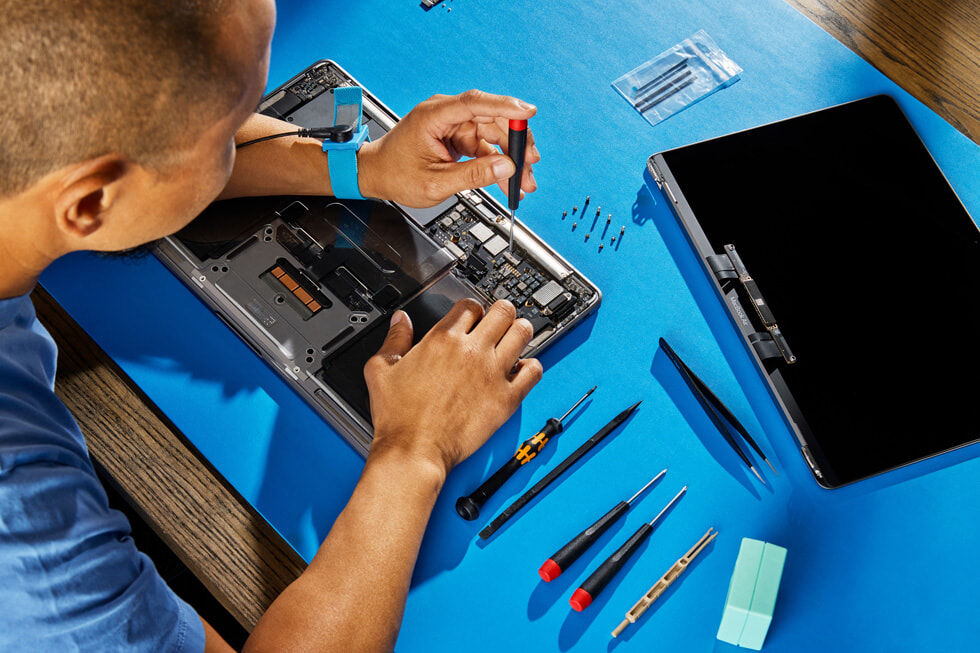
Samuel Axon
On Tuesday, Apple expanded its self-service repair program to M1-based MacBooks. Giving customers repair manuals and the ability to buy parts and buy or rent tools for M1 MacBook Airs and M1 MacBook Pros is a far cry from the Apple of yesteryear. But after a few days of availability, the MacBook self-repair program shows welcome progress, but work is required before Apple is considered a true right-to-repair ally.
The past few days have seen numerous right-to-repair activists critique Apple’s MacBook self-repair program. Perhaps most notable is a strongly worded blog from iFixit, which said the program “manages to make MacBooks seem less repairable.” While iFixit found the MacBook Air repair manual to be “in-depth, mostly logical, and well worth an additional repairability point,” it was less impressed with the MacBook Pro repair manuals.
iFixit focused heavily on Apple’s approach to MacBook Pro battery replacements, citing the natural degradation of lithium batteries. Apple’s 13, 14, and 16-inch 2021 MacBook Pro self-repair manuals say that to replace the battery, you need to remove far more than just the battery. The manuals instruct users to remove the entire top case, bottom case, battery management unit, flex cable, lid angle sensor, the trackpad and its flex cable, the vent/antenna module, the logic board, display hinge covers, the display, the laptop’s audio board, fans, the MagSafe 3 board, as well as the USB-C boards, and Touch ID board.

From Apple’s 14-inch M1 MacBook Pro repair manual.
Apple
That requires you to read through most of the 160-plus-page manual, which warns that “the battery is part of the top case” and that you shouldn’t try to separate the two. The manuals also note that the top case includes the BMU board, keyboard, keyboard flex cable, mic, and speakers, which are all “nonremoveable.”
Basically disassembling and reassembling a laptop to change its battery, a part known to need replacement after time, isn’t user-friendly or… typical. iFixit, for example, has a MacBook Pro 14-inch 2021 battery replacement guide that breaks the process down into 26 steps and removes mostly just the bottom case, trackpad, and battery board.
And a quick look at repair manuals for other PCs, such as Lenovo’s ThinkPad X1 Carbon [PDF] or HP’s Zbook Fury G8 have simpler, shorter battery replacement processes. Although, those designs differ from Apple’s MacBook Pros.
To replace the battery on an M1 MacBook Pro via Apple’s Self-Service Repair Store, you’ll have to buy an entire top case too, which will run you about $527-$615, minus an $88 credit if you send back your original part (you can see a deeper price breakdown in this handy price list from The Verge). That’s a steep price to pay for a new battery, especially if everything else is working.
Apple says it will eventually sell individual battery replacements for M1 MacBook Pros but hasn’t specified when. Until then, battery replacements done the Apple Self Repair Store Way are wildly time-consuming and expensive.
“… Apple is presenting DIY repairers with an excruciating gauntlet of hurdles: read 162 pages of documentation without getting intimidated and decide to do the repair anyway, pay an exorbitant amount of money for an overkill replacement part, decide whether you want to drop another 50 bucks on the tools they recommend, and do the repair yourself within 14 days, including completing the System Configuration to pair your part with your device. Which makes us wonder, does Apple even want better repairability?” iFixit’s content advisor Sam Goldheart wrote.
iFixit’s blog notes that Apple isn’t the only company to group self-service battery replacement with other repairs. The screen-battery replacement kit for the Samsung Galaxy S21 is an example. But Apple’s offense, iFixit argues, is worse.
“Apple requiring keyboard and top case replacements is worse than the Samsung OEM display assembly because it makes the repair significantly more difficult, requiring you to disassemble the entire device to replace a battery,” Elizabeth Chamberlain, iFixit’s director of sustainability, told Ars. She noted that while the S21’s battery-display assembly is “also unfortunate” it simplifies battery replacement.
iFixit’s blog also lamented the mysterious disappearance of repair manuals for the 21.5-inch and 27-inch iMacs that Apple published in 2019. We reached out to Apple asking about its reasoning and will update this if we hear back. But there’s hope that the manuals could return at some point (perhaps amended) as Apple continues expanding its self-service repair program.
A less pricey concern is replacing the M1 MacBook Air’s keyboard function row. It costs the same amount of money, $39, to replace it as it does to replace the keycaps on the keyboard. As The Verge pointed out, Apple, in a move that feels painfully wasteful in more ways than one, will sell users seven sets of function row keycaps for that price.
At Apple’s whim
Because Apple’s in charge of its self-serviceability efforts, there’s concern that Apple’s store will eventually make parts unavailable, limiting future self-repairs.
“They’re likely to phase out product part availability before the real life span of the hardware (our office is full of 2012 MacBook Pros, for instance),” Chamberlain told Ars.
Right-to-repair legislation has seen notable movement of late, including the first right-to-repair bill for electronics passing in New York. iFixit argued that further legislation is still necessary, despite Apple becoming more amenable to self-repairs. Because just as easily as Apple decided to better accommodate self-repairs, it can change its mind.

Repairing an M1 MacBook.
“When we’re at the whims of manufacturers, we get repair on their terms,” Chamberlain said. “Apple can take away product part support and repair manuals at any time—proven by the fact that they took down the 2019 iMac manuals.”




